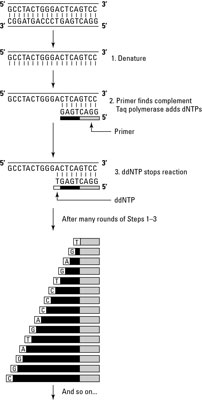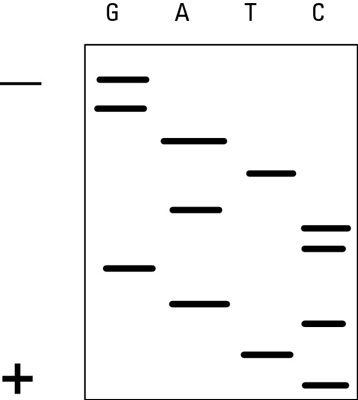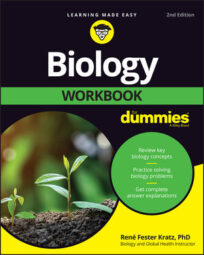DNA sequencing, which determines the order of nucleotides in a DNA strand, allows scientists to read the genetic code so they can study the normal versions of genes. It also allows them to make comparisons between normal versions of a gene and disease-causing versions of a gene.
After they know the order of nucleotides in both versions of a gene, they can identify which changes in the gene cause the disease.
DNA sequencing relies upon a special kind of nucleotide, called ddNTP (short for dideoxyribonucleotide triphosphate). ddNTPs are somewhat similar to regular DNA nucleotides, but they’re different enough that they stop DNA replication.
When a ddNTP is added to a growing chain of DNA, DNA polymerase can’t add any more nucleotides so the growing chain stops at that point. DNA sequencing uses this chain interruption to determine the order of nucleotides in a strand of DNA.
Most DNA sequencing done today is cycle sequencing (shown in the figure), a process that works like PCR to create many copies of the gene to be sequenced. But, unlike PCR, ddNTPs as well as regular nucleotides are added to the mix. So, as the DNA polymerase works away making many copies of the gene, every now and then it grabs a ddNTP (shown as white rectangles) instead of a regular nucleotide (shown as black rectangles).

After a ddNTP is added to a growing DNA molecule, replication is stopped. The end result of cycle sequencing is lots of partial copies of the gene to be sequenced, all of which are stopped at different points and are therefore different lengths.
After the partial copies are made, scientists load them into a machine that uses gel electrophoresis to put the copies into order by size. As the partial sequences pass through the machine, a laser reads a fluorescent tag on each ddNTP, which reveals the order of nucleotides in the gene.
Test your ddNTP reading comprehension with these practice questions:
A scientist wants to determine the sequence of a gene associated with a genetic disease. She takes samples of DNA a person who has the disease-causing version of the gene them into four separate test tubes, each containing nucleotides, DNA polymerase, and primers.
Then, into each tube, she adds one type of dideoxynucleotide — ddATP, ddGTP, ddCTP, or ddTTP — so that each tube will produce DNA fragments that end with a particular nucleotide (A, G, C, or T). After running the sequencing reactions, she loads the results of each tube into a gel and separates the fragments using gel electrophoresis.
Based on the results in her gel, shown in this figure, what is the sequence of the gene?

A young woman whose mother died from early onset Alzheimer’s wants to know whether she is at risk for developing the disease. The disease is caused by a dominant allele, so if the woman has just a single copy of the disease-causing allele, she’ll develop the disease.
Describe how a scientist could use a blood sample from the young woman to screen her for the presence of the disease-causing allele. Be sure to include all the necessary techniques, starting with the blood sample.
The following are the answers to the practice questions.
DNA travels toward the positive electrode in a gel, and the smallest fragments move the greatest distance, so the bands in the gel that are closest to the + are the smallest bands.
The shortest fragment (the lowest band) is in the lane that was loaded with ddCTPs, so the first nucleotide in the DNA strand must be C. The next band is in the lane that was loaded with ddTTPs, so the next nucleotide must be T.
The next band is again in the C lane, so the next nucleotide must be a C. If you continue reading the gel from the + side to the – side — in other words, from the bottom to the top — you can figure out the rest of the DNA sequence. The entire sequence is CTC AGC CAT AGG.
The scientist would extract DNA from the sample of blood and then use either DNA sequencing or restriction enzymes to determine whether the young woman carries the disease-causing allele.
DNA sequencing method: The scientist reads the sequences of the young woman’s alleles and compares them to the known sequences of the normal and disease alleles. The scientist separates the young woman’s DNA sample and places it into four tubes. Each tube contains primers for the Alzheimer’s gene and lots of nucleotides.
One of each tube contains a different fluorescently labeled ddNTP: one with ddATP, one with ddCTP, one with ddGTP, and one with ddTTP. The scientist places the tubes into a cycle sequencer, where they go through many rounds of DNA replication.
Then the scientist runs the samples through a gel that separates them by size. The computer detects the fluorescent signal at the end of each piece of DNA from smallest to largest and uses it to reconstruct the DNA sequences for the young woman’s alleles.
Restriction enzyme method: The scientist uses PCR on the DNA from the blood to make many copies of the gene associated with Alzheimer’s. Then the scientist uses a restriction enzyme that’s known to cut differently within the normal and disease forms of the gene.
The scientist cuts the young woman’s DNA sample with the restriction enzyme and then separates the DNA using gel electrophoresis. The scientist compares the sizes of the DNA fragments produced by the young woman’s DNA to the known pattern generated by the normal and disease alleles.

